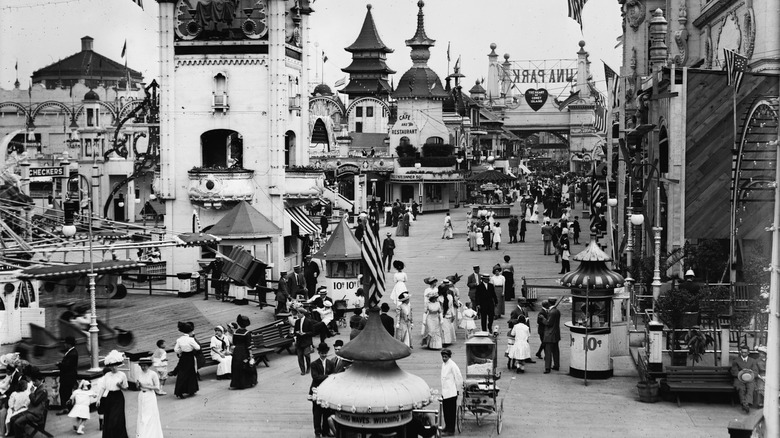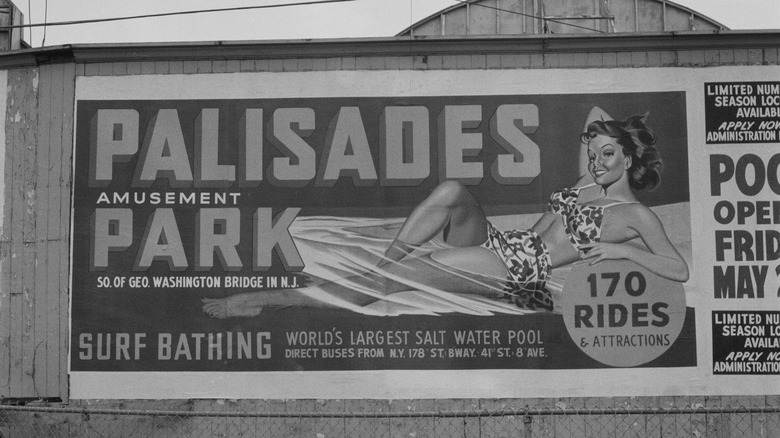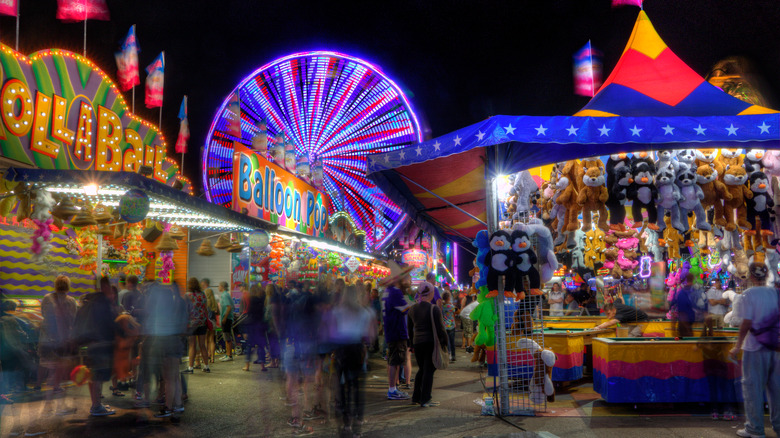The Risque Reason Tunnel Of Love Rides Became A Staple At Amusement Parks
According to the BBC, the concept of amusement parks began in Denmark in 1583. However, this soon evolved into what is known as "pleasure gardens." Made popular in 18th-century London, pleasure gardens allowed people to let loose and interact with others who were of a lower or higher social status. Moreover, both sexes engaged in risque behavior that would otherwise be seen as immoral in other situations. The National Amusement Park Historical Association states that eventually, pleasure gardens made their way to America. By the late 1800s, pleasure gardens were out and modern amusement parks were in (via Royal Caribbean).
Vox reports that this is largely thanks to New York's Coney Island. The publication explains that like pleasure gardens, Coney Island was a place where people were allowed to break away from accepted social constructs. According to Brooklyn Museum, one popular ride at the amusement park was the Tunnel of Love. Mental Floss writes that Tunnel of Love rides are a thing of the past. Nevertheless, they continue to live on in pop culture. Per Hopes&Fears, various cartoons from the 1990s referenced the ride. Although many no longer exist, Tunnel of Love rides were once responsible for bringing an air of romance to amusement parks.
The Tunnel of Love was designed for unwed couples
Hopes&Fears reports that the first Tunnel of Love, known as "The Canals of Venice," was designed in London. With the rise of amusement parks in America in the 20th century, the ride became increasingly popular (via Mental Floss). However, it was then referred to as the Old Mill. According to the Pittsburgh City Paper, the Old Mill was designed to be a slow boat ride for amusement parks. Couples took this opportunity to get some alone time together. That said, the Tunnel of Love came along when Palisades Park in New Jersey opted to rebrand their Old Mill ride into something that was more romantic.
Mental Floss adds that they capitalized on the fact that couples were using Old Mill rides to physically touch. As the ride was usually six minutes long, couples made sure to kiss and hold on to each other during this brief time frame. The publication states that unless a couple was married, it was socially unacceptable for them to be alone until the Tunnel of Love came along. As Dale Samuelson, author of the 2001 book "American Amusement Park," explained, "the darkness became a big draw for romantically inclined couples looking for a little intimacy in a time when any public display of affection was frowned upon."
The oldest Tunnel of Love is in Minnesota
Per Hopes&Fears, it's believed that Tunnel of Love rides began to decrease in popularity in the 1920s. As the times changed, physical interaction between the sexes became more acceptable — they no longer needed to go on the Tunnel of Love for a moment of intimacy. Mental Floss adds that the sexual revolution later contributed to their decline. Although there were 700 Tunnel of Love rides in the 1950s, they are now nearly extinct. However, in "The American Amusement Park," Samuelson notes that these rides have left a significant legacy. Old Mill and Tunnel of Love rides later inspired various rides at Disneyland.
In 2015, the National Roller Coaster Museum reported that only five Tunnel of Love rides still existed in the United States. The oldest of those remaining was built by John Keenan in 1915 (via Fox 21), called Ye Old Mill. Despite its old age, the ride still has the same motor. In an interview with Fox 21, Keenan's great-grandson, Jim Keenan, confessed, "I remember sneaking peeks in the trap doors trying to catch people kissing and things like that."
The Keenan family continued to own and operate the ride until 2018 when it sold Ye Old Mill to the Minnesota State Fair (per MPR News). Jerry Hammer, the general manager of the Minnesota State Fair, explained why the fair decided to purchase the ride. He stated, "There are some traditions that really need to be preserved, and that's one of them."


